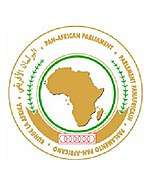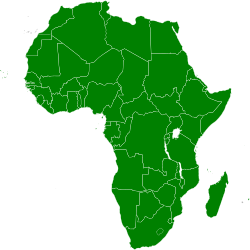Pan-African Parliament
The Pan-African Parliament (PAP), also known as the African Parliament, is the legislative body of the African Union and held its inaugural session in March 2004. The PAP exercises oversight, and has advisory and consultative powers, lasting for the first five years. Initially the seat of the Pan-African Parliament was in Addis Ababa, Ethiopia, but it was later moved to Midrand, Johannesburg, South Africa.
Pan-African Parliament
| |
|---|---|
 | |
| History | |
| Founded | 18 March 2004 |
| Leadership | |
Roger Nkodo Dang (Since 2015) | |
Vice-presidents | |
| Structure | |
| Committees | Permanent Committees of the Pan-African Parliament
|
| Meeting place | |
| Gallagher Convention Centre, Midrand, South Africa | |
| Website | |
| panafricanparliament.org | |
On 28 October 2009, the second legislature of the Pan-African Parliament opened its first ordinary session and began a new five-year mandate. South African President Jacob Zuma gave the opening speech and called for the PAP to be given full legislative powers and its members elected by universal suffrage.[1]
Structure
The Parliament is made up of three main bodies. There are also Ten Permanent Committees, which were created to deal with different sectors of life in Africa.
Plenary
The Plenary is the main decision-making body of the Parliament. The Plenary consists of the delegates from the member states, and is chaired by the President. It is the body which passes resolutions.
The Pan-African Parliament has 235 representatives that are elected by the legislatures of 47 of the 54 AU states, rather than being directly elected in their own capacity.[2] Each member state sends a delegation of five parliamentarians to the Parliament, at least one of whom must be a woman. The composition of the delegation should reflect the political diversity of the member state's legislature.[3]
Bureau
The Bureau is the leadership group of the Parliament and consists of the President and four Vice-Presidents. Each member of the Bureau represents a different region of Africa. The current members of the Bureau are:[4]
- President - Roger Nkodo Dang from Cameroon, representing Central Africa
- First Vice-President - Stephen Julius Masele from Tanzania, representing East Africa
- Second Vice-President - Haidara Cissé from Mali, representing West Africa
- Third Vice-President - Bouras Djamel from Algeria, representing Northern Africa
- Fourth Vice-President - Chief F. Z. Chirumbira from Zimbabwe, representing Southern Africa[5]
Secretariat
The Secretariat assists in the day-to-day running of the Parliament, undertaking duties such as minuting meetings, organising elections and managing staff. The Secretariat consists of a Clerk, two Deputy Clerks and other support staff.[6]
The current members of the Secretariat are:[7]
- Acting Clerk – Yusupha Jobe (The Gambia)
- Deputy Clerk (Legislative Business) – Gali Massa Harou (Chad)
- Acting Deputy Clerk (Finance, Administration and Human Resource) – Charlotte Marck (Zimbabwe)
History
The Abuja Treaty and Sirte Declaration called for the creation of a PAP. The former had simply listed the PAP among the organization's bodies and stated, "In order to ensure that the peoples of Africa are fully involved in the economic development and integration of the Continent, there shall be established a Pan-African Parliament. The composition, functions, powers and organisation of the Pan-African Parliament shall be defined in a Protocol providing thereof." The Treaty on the Establishment of the African Union and a Protocol to the Treaty Establishing the African Economic Community relating to the Pan-African Parliament followed. Then there was the Constitutive Act of the African Union. The Protocol Establishing the Pan African Parliament was adopted in 2000 during the OAU Summit in Lomé, Togo. The Protocol is now open for signature and ratification. So far 21 member states have signed and three have ratified. Article 22 of the PAP protocol provides for the Protocol to enter into force after deposit of the instruments of ratification by a simple majority of the member states.
Objectives of the Parliament
 |
|---|
| This article is part of a series on the politics and government of the African Union |
|
Executive
|
|
Legislature
|
|
Advisory bodies
|
|
Financial bodies |
|
Decentralised bodies
|
|
Related topics |
- Implement the policies and objectives of the African Union.
- Cultivate human rights and democracy in Africa.
- Make sure Member States adhere to good governance, transparency and accountability.
- Let the peoples of Africa know what the objectives and policies of the African Union are so that they might be able to integrate themselves continentally while still working within the framework of the AU.
- Engender peace, security and stability on the Continent.
- Promote self-reliance and economic recovery so as to lead to a more prosperous future for the peoples of Africa.
- Engender cooperation and development in Africa.
- Strengthen a sense of solidarity and build common destiny among the peoples of Africa.
- Create cooperation among Regional Economic Communities and their Members in Parliament.
Powers of the Parliament
- Examine, discuss or express an opinion on any matter, either on its own initiative or at the request of the Assembly or other policy organs and make any recommendations it may deem fit relating to, inter alia, matters pertaining to respect of human rights, the consolidation of democratic institutions and the culture of democracy, as well as the promotion good governance and the rule of law.
- Discuss its budget and the budget of the Community and make recommendations thereon prior to its approval by the Assembly of the African Union.
- Work towards the harmonisation or co-ordination of the laws of the Member States.
- Make recommendations aimed at contributing to the attainment of the objectives of the OAU/AEC and draw attention to the challenges facing the integration process in Africa as well as the strategies for dealing with them.
- Request officials of the OAU/AEC to attend its sessions, produce documents or assist in the discharge of its duties.
- Promote the programmes and objectives of the OAU/AEC, in the constituencies of the Member States.
- Promote the co-ordination and Harmonization of policies, measures, programmes and activities of the Regional Economic Communities and the parliamentary fora of Africa.
- Adopt its Rules of Procedure, elect its own President and propose to the Council and the Assembly the size and nature of the support staff of the Pan-African Parliament.
- Perform such other functions as it deems appropriate to achieve the objectives set out in Article 3 of the Protocol.
In one of its first actions the Pan African Parliament agreed to send a fact-finding mission to the Darfur region of Sudan.
Trust fund
A trust fund was established 26 May 2005. In the motion to create the fund, it was said the Pan-African Parliament Trust Fund will promote "good governance, transparency and democracy, peace security and stability, gender equality and development in the integration of African people within Africa and other nations. It will also support the fight against HIV/AIDS, hunger and poverty on the continent".[8]
Presidents of the Pan-African Parliament
| President of the Pan-African Parliament | |
|---|---|
| Appointer | The Assembly |
| Term length | Three years |
| Inaugural holder | Gertrude Mongella |
| Formation | 2000 |
| Organization of African Unity | ||||
|---|---|---|---|---|
| No | Name | Beginning of term | End of term | Country |
| 1 | Gertrude Mongella | 2000 | 2008 | |
| 2 | Idriss Ndele Moussa | 2009 | 2012 | |
| 3 | Bethel Nnaemeka Amadi | 2012 | 2015 | |
| 4 | Roger Nkodo Dang | 2015 | present | |
See also
- List of members of the Pan-African Parliament
- Bureau of the Pan-African Parliament
- United States of Africa
- African Parliamentary Union, another inter-parliamentary institution only of some African countries
- European Parliament, the European counterpart
References
- "The Task Ahead for the Pan African Parliament". Mathaba News Network. Retrieved 9 November 2009.
- "About PAP - General Overview". Archived from the original on 24 April 2015.
- "About PAP". Pan African Parliament. Archived from the original on 2 March 2018.
- "Bureau". Archived from the original on 18 February 2015.
- "Hon. Safia Elmi Djibril elected as PAP VP of the Eastern Africa Region". panafricanparliament.org. Pan-African Parliament. Retrieved 7 August 2016.
- "Secretariat".
- "Secretariat".
- "Establishment of the Pan-African Parliament Trust Fund". Archived from the original on 2 March 2009. Retrieved 9 November 2009.